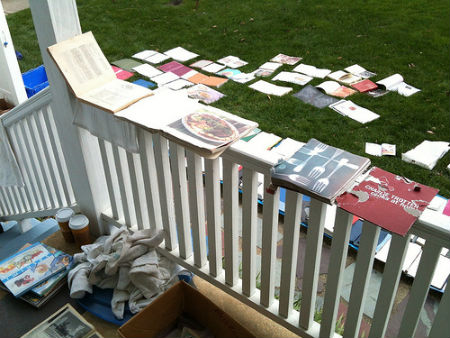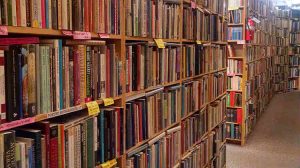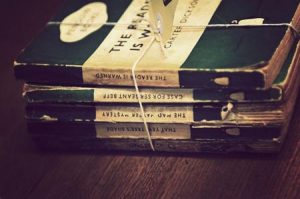
Having a flood or water damage in your home can be a disaster. Not only can it ruin your floors and walls, it can also cause damage to anything that happens to be in its path. Unfortunately, this can include your collection of books and papers.
When a book has been damaged by water, many people might think that it is completely unsalvageable. However, although there might be a little bit of physical distortion, the book can be saved and can be repaired to a readable standard. If you have books, letters, old tax returns, birth certificates or marriage licenses which have been that have been damaged by water, it is possible to save them even if they have been drenched.
Remember that the books don’t have to have been touching the water to be potentially damaged. When the room is filled with water, the books close to it can suffer from the extra humidity and can potentially grow mold.
What if the water was dirty?
If the books have been in dirty flood water, you might need to rinse them clean before you begin the drying process. Gently rinse them in a sink or a bucket of cold, clean water. If you think that rinsing them in a bucket might damage them, you can also lay the paper on a flat surface and gently spray it with clean water as well. Be sure not to scrub the pages as doing so will tear the fibers. Loose, dry dirt can often be removed with a soft-bristled brush.
Remove the dampness as soon as possible.
The most important thing is to remove the dampness from the books and papers as soon as possible – before the mold has a chance to grow. Carefully wipe off the covers. Again, don’t scrub – just blot. You should lay the books and the papers on blotter paper, which is very good at absorbing moisture. You could also use paper towels, but make sure that you stick to the plain white or unbleached ones, as printed towels may bleed onto the pages. Newspaper should also be avoided, because the ink will transfer to the book.
Drying the books

The best way to dry your water-logged books is to place a sheet of absorbent paper between the wet pages and lay the book flat to dry. You don’t necessarily have to place the absorbent blotter paper between every page – just every 20 pages or so. As the blotter paper becomes saturated, you can change it every few hours. It is also a good idea to place an oscillating fan in the room where the papers are drying, so that you can increase the air circulation and help them to try faster.
What if there’s no time to dry the books immediately?
Ideally, this process should be completed as soon as possible, so that the books don’t have a chance to get moldy. However, if time is short, the best thing to do is to place the books in a resealable plastic bag and put them in the freezer. This will stop the paper from deteriorating any further.
That musty smell
When your books and papers have finished drying, they may still have a musty smell. In order to get rid of this, you can place them, propped open, in an open box and then put that in a different larger closed container – with an open box of baking soda. As long as the baking soda doesn’t touch the books, it will absorb the odor. Clean cat litter can also be used. This process may take a while.
How to prevent it from happening again: store your books high!
If you want to avoid your books being damaged by flooding in the future, you should do your best to keep them as high up as possible. Although they still might suffer from humidity damage, they will be a lot safer than if they were in boxes on the floor. There are many stylish bookcases, where you can store your most precious books and papers high up and away from the risk of flooding damage.
With these tips, you can salvage your books and important papers, so that a flood isn’t necessarily a death sentence for all of your books. While they’ll not be in the nearly-pristine condition desired by collectors, you’ll still be able to read and enjoy them.
Do you have other tips for saving damaged books? Share them with us below!




Rick Reese says
How do you separate pages that have been wet and dried stuck together?
Denise says
Once they’re dried and stuck together, they may not be able to be separated again without damage. However, you could try re-wetting and prying them apart, very carefully.
Harry Smulson says
I’m a green-pea when it comes to computers and collectible books; but I’m there non the less. I have copied several of your articles 0n books and steps to make me more knowledgeable: they are wonderful. I’m an old man (85) looking for a way to make an honest dollar for my wife and my self: I’m retired (USAF & SS) and I’m NOT looking for sympathy but I just want to THANK YOU for your material. Sincerely, Harry Smulson. ps I have collected nearly two thousand books and about 500 National Geographic magazines. So far I’ve sold one book !!!!
MOSHE says
Hello
My book is dry now but pages have become wavy after getting soaked by humidity… How I turn the book back to its original flat condition?
Thank you.
D. Raphael says
Hi Moshe,
You can try stacking heavy books on top of it, but most likely the waves will remain. I wish I had better news for you, but I don’t know of any reliable way to get the waves out, or to return the book to its original condition. Good luck!
all best,
Denise
MOSHE says
Hi Denise.
I did it. I stacked almost all my library (lol!) until it touched the ceiling on this small copy of Patrick Modiano, the Nobel Prize winner,- all in vain: it is still wavy.
The Israeli post office is responsible for many damaged books I got during my collecting years, no money back, nothing.
PS: since we’re talking about blemished books, how I remove a library ink stamp?
Thank you for your kind reply.
D. Raphael says
Hi Moshe,
I’m sorry to hear that the waves wouldn’t come out…but I suppose that’s how it usually goes. Unfortunately.
I don’t know of any way to remove a library ink stamp inside the book.
However, if the stamp is on the edge of the page block, and very superficial, sometimes if you use a fine-grit sandpaper (VERY gently) you can remove it. I’ve heard of that method used to remove lightly-inked remainder marks from the lower edge of the page block, but have never been brave enough to try it myself!
A library mark or won’t necessarily ruin the value of the book. It’s more the end result that matters. I’ve seen a few which looked almost pristine, with the exception of a single library mark, and kept much of their value. But others looked like they were the result of a sloppy arts-and crafts project and were only good as reading copies. It just depends.
What sort of books do you collect?
cheers –
Denise